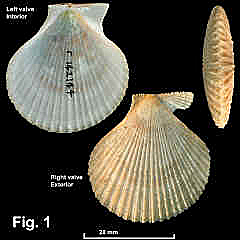|
|
PECTINIDAE |
|
|
|
Talochlamys pulleineana (Tate, 1887) Description: Shell lightweight. Shape slightly higher than wide plus very inequal auricles, weakly prosocline. Byssal notch below auricle of right valve. Both valves weakly inflated. Exterior of both valves sculptured with 20-24 unevenly spaced, scaly, narrow primary ribs, with zero, one, or two scaly secondary riblets between primaries in later stages of growth; sometimes with wavy commarginal lamellae across interspaces between primary ribs. Auricles strongly ridged and scaled. Interior with primary exterior ribs showing through. Hinge line long, straight, with several elongate teeth. Shell colour white, cream orange or pink with pale radial streaks or blotches. Size: Up to about 30 mm high. Distribution: SE of Cape Capricorn, central Qld, southwards and around southern Australia, to off Shark Bay, WA, including Tas. Habitat: The Australian Museum collection contains specimens from 66-1000 m depth. Comparison: When naming this species (as Chlamys famigerator) in 1925, Iredale said it had been a difficult task to separate it from M. asperrima, which, given Iredale’s proclivity for splitting species, underlines the similarity of the two. Tate, when he described P. pulleineanus, said it was “less orbicular and flatter, with the ribs not interrupted on the flanks”, but I am unable to confirm his observations when looking at a range of NSW specimens. Synonymy: Shells from southern NSW were named Chlamys famigerator Iredale, 1925, later placed in Mimachlamys. More recently it became apparent that the earliest name is Pecten pulleineanus Tate, 1887, assigned to specimens collected from the south-east coast of SA by R.H. Pulleine. Remarks: This is a difficult species; if it is only one species then it is very variable in sculpture. The amount of scaling on the primary ribs varies from all ribs densely scaled to all ribs completely smooth. The number of secondary ribs between primaries is variable from none at all to one or two. The amount of cross lamination between primary ribs is absent more often than present. Fig. 1: East of Broken Bay, NSW, 410-506 m (C.142144) |
|
